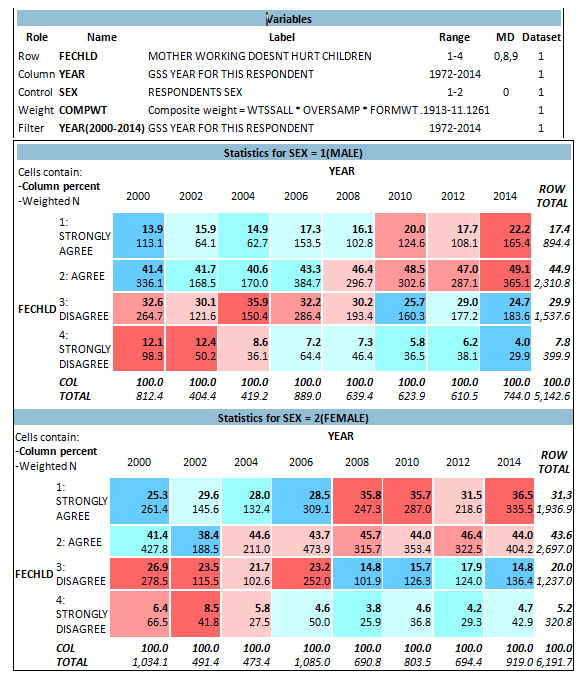Which of the following statements is true, based on the information presented in Figure 7.1?
Figure 7.1

A team of researchers is interested to know whether beliefs about working mothers are related to respondents’ gender, and how these beliefs have changed over recent years. They make a cross-tab of FECHLD by YEAR, using SEX as a control variable. The variable FECHLD corresponds to the survey question, “Please tell me whether you strongly agree, agree, disagree, or strongly disagree with it… A working mother can establish just as warm and secure a relationship with her children as a mother who does not work.”
a. For both men and women respondents, most disagree with the idea that “A working mother can establish just as warm and secure a relationship with her children as a mother who does not work”
b. From 2000 to 2014, the percentage of men who strongly agreed with the idea that “A working mother can establish just as warm and secure a relationship with her children as a mother who does not work” has generally decreased.
c. In 2014, the percentage of women who either disagreed or strongly disagreed with the idea that “A working mother can establish just as warm and secure a relationship with her children as a mother who does not work” was higher than the percentage of men who either disagreed or strongly disagreed with this idea.
d. In 2014, the percentage of women who strongly agreed with the idea that “A working mother can establish just as warm and secure a relationship with her children as a mother who does not work” was higher than the percentage of men who strongly agreed with this idea.
d. In 2014, the percentage of women who strongly agreed with the idea that “A working mother can establish just as warm and secure a relationship with her children as a mother who does not work” was higher than the percentage of men who strongly agreed with this idea.
You might also like to view...
If older adults are primed with negative aging stereotypes, and their subsequent performance on memory tests is worse than older adults who were primed with positive aging stereotypes, then we can conclude that older persons are vulnerable to
a. bias in memory testing. b. stereotype threat. c. activation of implicit beliefs. d. learned helplessness.
Meta-analysis is ____________ .
A. a powerful tool as it allows scientists to determine whether a finding generalizes a study. B. a powerful tool as it allows people to determine whether a finding generalizes across many studies that used different methods. C. a confusing tool that does not allow people to determine whether a finding generalizes a study. D. None of these
Evaluate the concept of the government providing services to the elderly as opposed to the family
What will be an ideal response?
Political leaders in all societies surround themselves with symbols of office in order to help legitimize their authority. Symbols of authority might include all but which of the following?
a. An instructor’s podium b. A police officer’s uniform c. A presidential entourage d. An inmate’s uniform